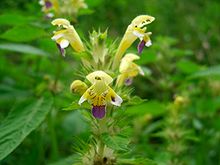
Back Lipblomme Afrikaans Lippenblütlerartige ALS شفويات Arabic شفويات ARZ Lamiales AST Dalamazçiçəklilər Azerbaijani Lamiales BCL Ясноткакветныя Byelorussian Ясноткакветныя BE-X-OLD Устноцветни Bulgarian
| Lamiales Temporal range:
| |
|---|---|

| |
| Galeopsis speciosa | |
| Scientific classification | |
| Kingdom: | Plantae |
| Clade: | Tracheophytes |
| Clade: | Angiosperms |
| Clade: | Eudicots |
| Clade: | Asterids |
| Clade: | Lamiids |
| Order: | Lamiales Bromhead[2] |
| Families[3] | |
| |
This article includes a list of general references, but it lacks sufficient corresponding inline citations. (May 2012) |
The order Lamiales (also known as the mint order) are an order in the asterid group of dicotyledonous flowering plants.[4][5] It includes about 23,810 species, 1,059 genera, and is divided into about 25 families.[4] These families include Acanthaceae, Bignoniaceae, Byblidaceae, Calceolariaceae, Carlemanniaceae, Gesneriaceae, Lamiaceae, Lentibulariaceae, Linderniaceae, Martyniaceae, Mazaceae, Oleaceae, Orobanchaceae, Paulowniaceae, Pedaliaceae, Peltantheraceae, Phrymaceae, Plantaginaceae, Plocospermataceae, Schlegeliaceae, Scrophulariaceae, Stilbaceae, Tetrachondraceae, Thomandersiaceae, Verbenaceae.[4]
Being one of the largest orders of flowering plants, Lamiales have representatives found all over the world. Well-known or economically important members of this order include lavender, lilac, olive, jasmine, the ash tree, teak, snapdragon, sesame, psyllium, garden sage, and a number of table herbs such as mint, basil, and rosemary.[6]
- ^ M. E. J. Chandler. 1964. The Lower Tertiary Floras of Southern England. IV. A summary and survey of findings in the light of recent botanical observations.
- ^ Cite error: The named reference
APG3was invoked but never defined (see the help page). - ^ Cite error: The named reference
APG4was invoked but never defined (see the help page). - ^ a b c Allaby, Michael, ed. (2019). A Dictionary of Plant Sciences (4 ed.). Oxford University Press. doi:10.1093/acref/9780198833338.001.0001. ISBN 978-0-19-883333-8.
- ^ Cite error: The named reference
Springer-2004was invoked but never defined (see the help page). - ^ Schäferhoff, Bastian; Fleischmann, Andreas; Fischer, Eberhard; Albach, Dirk C; Borsch, Thomas; Heubl, Günther; Müller, Kai F (2010). "Towards resolving Lamiales relationships: insights from rapidly evolving chloroplast sequences". BMC Evolutionary Biology. 10 (1): 352. Bibcode:2010BMCEE..10..352S. doi:10.1186/1471-2148-10-352. ISSN 1471-2148. PMC 2992528. PMID 21073690.